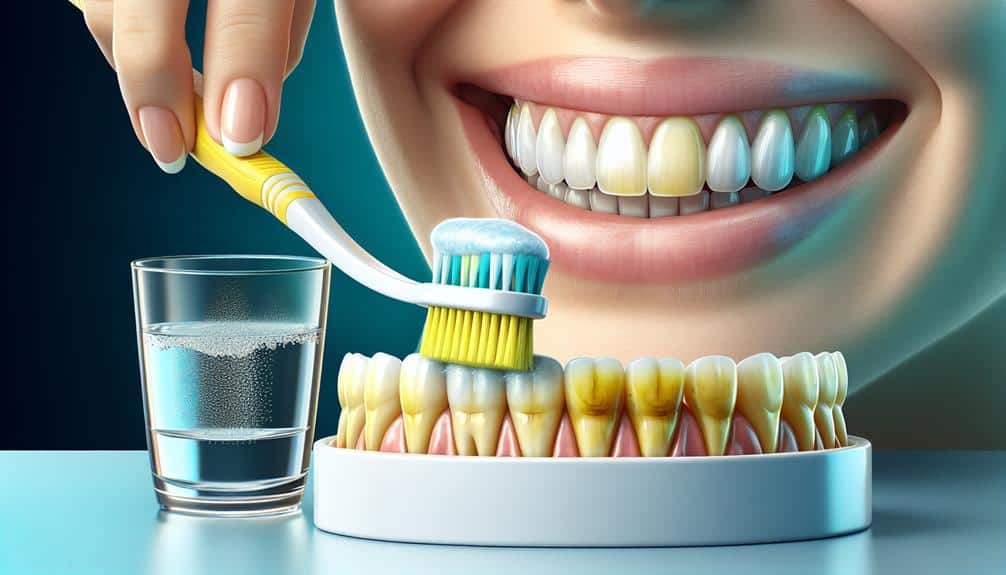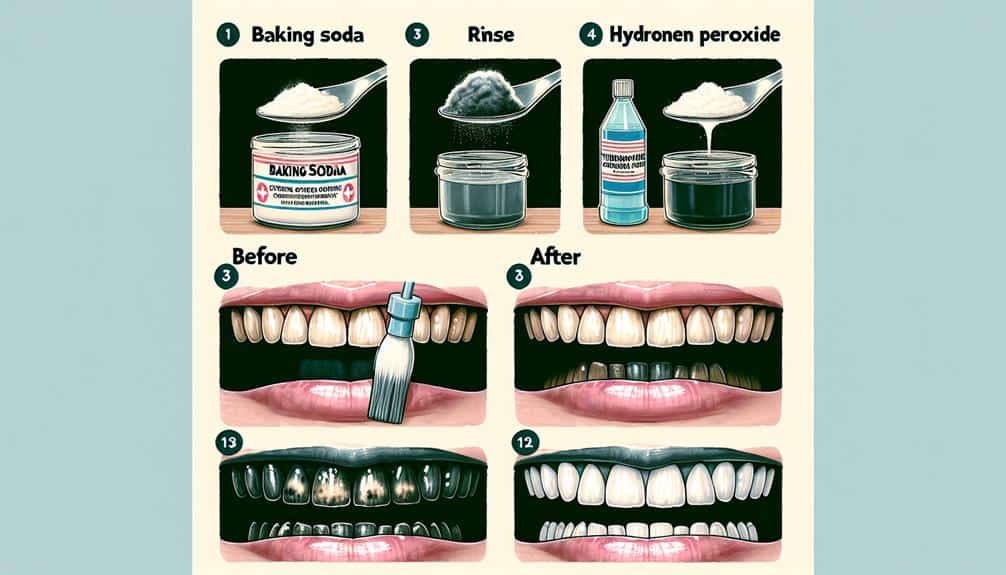When dealing with stubborn Tetracycline stains that mar your smile, a detailed whitening guide is essential. Understand the causes and severity of these deep-set stains. Explore professional options like laser treatments for effective results. At-home remedies, like baking soda or hydrogen peroxide, offer convenience but consult with your dentist first. Maintain a whiter smile with daily oral care habits, whitening toothpaste, and mindful food choices. Be aware of potential risks like tooth sensitivity and enamel damage when using whitening products. Seek advice from a dental professional for the best approach to tackle Tetracycline stains.
Key Points
- Professional whitening effectively improves Tetracycline stains with advanced cosmetic dentistry treatments.
- Laser therapy targets deep stains, breaking down pigmentation for successful whitening results.
- At-home remedies like baking soda or hydrogen peroxide offer convenient solutions for Tetracycline stains.
- Maintain whiter teeth by brushing with whitening toothpaste, flossing daily, and avoiding stain-causing foods.
- Consult a dentist for suitable whitening approaches, as overuse of products can harm tooth enamel.
Understanding Tetracycline Stains
Understanding Tetracycline Stains involves delving into the intricate interactions between the antibiotic and the tooth structure, resulting in discoloration that varies in severity and distribution. The causes of Tetracycline stains lie in the binding of the antibiotic to the calcium ions in the developing teeth, leading to the incorporation of the drug into the tooth structure. The severity of the stains can range from light yellow or brown to dark gray or blue, depending on factors such as dosage, duration of use, and individual tooth characteristics.
Treatment of Tetracycline stains can be challenging due to their deep penetration into the tooth enamel and dentin. Traditional whitening methods like over-the-counter products or professional cleanings may not effectively address these intrinsic stains. More advanced treatment options such as microabrasion, veneers, or bonding may be considered to mask or reduce the appearance of Tetracycline stains. Consulting with a dental professional is essential to determine the most suitable treatment plan tailored to your specific case.
Professional Whitening Options
When addressing Tetracycline stains, exploring professional whitening options can provide effective solutions to improve the appearance of discolored teeth caused by antibiotic interactions. Cosmetic dentistry offers various treatments tailored to address such challenging stains. One prominent method is laser treatment, which has shown remarkable success in whitening teeth affected by Tetracycline discoloration.
Cosmetic dentistry professionals utilize laser technology to target the deep-set stains caused by Tetracycline antibiotics. The laser energy breaks down the pigmentation, helping to lift the stains and restore a more natural tooth color. Laser treatment is a precise and efficient way to whiten teeth and can significantly improve the appearance of Tetracycline-stained teeth.
At-Home Whitening Solutions
Exploring at-home whitening solutions can provide a convenient and cost-effective way to address Tetracycline stains on teeth, offering individuals the opportunity to improve their smile in the comfort of their own home.
When considering at-home remedies for Tetracycline stain whitening, DIY remedies and natural alternatives are popular choices.
DIY remedies often involve using ingredients like baking soda, hydrogen peroxide, or activated charcoal to create homemade whitening pastes. These solutions can help reduce the appearance of Tetracycline stains over time with regular use.
Natural alternatives such as strawberries, lemon peels, or coconut oil pulling are also believed to have whitening properties that may help combat Tetracycline stains.
It's essential to approach at-home whitening solutions with caution, ensuring they're safe for your teeth and gums. Consulting with a dentist before trying any DIY or natural whitening methods is advisable to prevent any potential harm to your oral health.
Tips for Maintaining Whiter Teeth
To maintain a whiter smile and prolong the effects of whitening treatments, it's important to establish consistent oral hygiene habits that promote the prevention of new stains. Vital care plays a pivotal role in maintaining the brightness of your teeth. Here are some tips to help you maintain your whiter teeth:
- Brush Regularly: Brush your teeth at least twice a day with a fluoride toothpaste to remove surface stains and prevent plaque buildup.
- Floss Daily: Make flossing a daily habit to clean between your teeth and along the gumline, where stains can easily accumulate.
- Use Whitening Toothpaste: Incorporate a whitening toothpaste into your oral hygiene routine to help maintain the whiteness of your teeth.
- Watch Your Diet: Avoid foods and beverages that are known to stain teeth, such as coffee, tea, and red wine.
- Drink Water: Rinse your mouth with water after consuming stain-causing foods or drinks to help prevent discoloration.
Risks and Considerations
Consider the potential risks and important factors to keep in mind when undergoing whitening treatments for tetracycline stains on your teeth. While whitening procedures can effectively reduce the appearance of tetracycline stains, it's important to be mindful of potential side effects. Some individuals may experience tooth sensitivity or gum irritation during or after treatment. Precautions such as using desensitizing toothpaste or reducing the frequency of whitening sessions can help minimize these risks.
Moreover, understanding the long-term effects of whitening treatments is vital. Overuse of whitening products may harm tooth enamel or lead to uneven whitening results. It's recommended to consult with a dental professional to determine the most suitable whitening approach for your specific case. Additionally, exploring alternatives like veneers or bonding can provide lasting results without the potential risks associated with whitening.
Frequently Asked Questions
Can Tetracycline Stains Be Completely Removed With Whitening Treatments?
Tetracycline stains can be noticeably lightened with whitening treatments, yet complete removal may be challenging. Long-term effectiveness varies. These stains, originating from antibiotic use during tooth development, can impact self-esteem due to their visibility.
Are There Any Specific Foods or Drinks That Should Be Avoided to Prevent Tetracycline Stains From Worsening?
To prevent the worsening of tetracycline stains, avoid foods and drinks like coffee, tea, and red wine that can contribute to stain progression. Dietary restrictions play a key role in stain management for a brighter smile.
How Long Does It Typically Take to See Results From Professional Whitening Options for Tetracycline Stains?
You'll witness a radiant transformation in your smile after undergoing professional whitening for tetracycline stains. Typically, results start to show within a few weeks, and the treatment duration can range from a few sessions to a couple of months.
Are There Any Alternative Treatments or Procedures for Tetracycline Stains Besides Whitening?
For tetracycline stains, alternative solutions like restoration options through cosmetic dentistry can help. Home remedies may offer minimal improvement. Consult a professional to explore non-whitening treatments that can address tetracycline stains effectively.
Is It Possible for Tetracycline Stains to Return After Successful Whitening Treatments?
Absolutely, tetracycline stains can resurface after whitening. Studies show up to 24% stain recurrence. Long-term effects vary. Consider maintenance treatments for prevention. Alternative options like veneers or bonding might provide lasting results. Stay informed for best outcomes.



